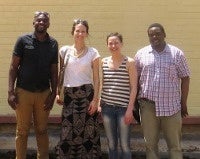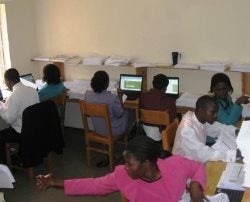
Left to right: Sydney Lungu (Data Manager), Sara Yeatman, Jenny Trinitapoli (Penn State), and Abdallah Chilungo (Project Manager)
Although the world has been distracted lately by the recent deadly Ebola outbreaks, HIV is still the leading infectious killer and one of the most serious health problems facing the planet's population. According to the U.S. Department of Health & Human Services, since 1981, when the first cases were reported, an estimated 39 million people have died of AIDS-related causes. There are currently more than 35 million people living with HIV worldwide. More than 70% of these people live in sub-Saharan Africa. In many countries in this region, the prevalence of HIV is as much as 10–20% of the general population. The disease plays a big role in the high mortality rates in the region and adds a heavy burden to the economic development of these African nations. It may also have dramatic implications for family life and personal relationships. As a sociologist and demographer, Assistant Professor of Health and Behavioral Sciences Sara Yeatman seeks to help define and understand these implications and provide insight to how one African community is living with the HIV/AIDS epidemic.
In 2009, Yeatman and her colleague Jenny Trinitapoli of Pennsylvania State University built a research center in the town of Balaka, in rural southern Malawi, called Tsogolo la Thanzi (TLT). In the local Chichewa language, Tsogolo la Thanzi means "Healthy Futures." The center was the base of operations for a three-year longitudinal study analyzing how people in Malawi navigate major life events and decisions such as marriage and childbearing in the climate of an AIDS epidemic. The study collected data from eight sets of comprehensive interviews given over three years on a randomly selected sample of the local population consisting of 1,500 women and 600 men. The study focused primarily on young adults in their prime childbearing years who are among the first cohort to have never lived without the specter of HIV. The respondents answered questions about their daily lives, families, partners, childbearing, health, HIV status, and their expectations for the future. TLT employed 50–60 local Malawians as interviewers, project managers, data entry specialists, guards, and nannies, and worked under the permission of the District Commissioner. Due to the extremely sensitive nature of the questions being asked of the respondents, and the HIV testing done on the participants, Yeatman and her local crew also sought approval and understanding from communities and traditional village authorities prior to conducting their intensive surveys. Because of their careful preparation and respectful treatment of culturally sensitive information, the project largely avoided any resistance and maintained impressively high participation and retention rates: More than 96% of the eligible people invited to participate in the study joined and 80% of those saw the project through to completion.

Tsogolo la Thanzi interviewers and project managers in front of the TLT building in Balaka
Yeatman's team had to get creative in their methods when it came to gathering the most sensitive information from their subjects. One technique interviewers used to get respondents to answer intimate or embarrassing questions was to give the respondents ten beans with which they could indicate their answers. Respondents answered difficult questions, such as, "How likely is it that you are HIV positive?" by pushing the number of beans forward that reflected their responses. Ten beans would mean certain positive, zero beans certain negative, and responses in the middle some level of uncertainty. Interviewers reported that they felt respondents were more honest when they could avoid eye contact with them and use the beans to indicate their answers. Perhaps the most interesting technique used in the study was something called the Best Friend Report. The Best Friend Report was a section of the questionnaire that asked the respondent to think about their best friend and then report on some of that friend's behaviors and life events. Of particular interest on these reports were the topics on which respondents are known to under self-report because of legal stigma and cultural taboo, such as abortion and sexual partners. Though there are some problems with this approach, when compared with self-reporting on these topics the numbers of reported behaviors on Best Friend Reports are much closer to what is expected by overall prevalence and helped the researchers draw a more complete picture.
Yeatman was invested in exploring the effects of AIDS in Malawi well before the Tsogolo La Thanzi study. She was a contributor to a paper that appeared in the academic journal Population and Development Review in September 2014 that compared the way local Malawians experienced and talked about AIDS in conversational journals with how the discussion was represented in Malawian newspapers from 1999–2008 titled "Popular moralities and institutional rationalities in Malawi's struggle against AIDS." This research showed the media demonstrating a shift in focus toward social responsibility and institutional changes in access and approaches to transmission control while the conversational journals showed that most Malawians were still more concerned about individual behaviors.
The data collected from the 2009–2012 TLT study has now been cleaned, compiled, and are available for analysis. Recently, Yeatman published another paper on one of the study's many compelling questions: How do partners affect each other's family size preferences and how do family size preferences affect the choice of a partner? "The Relationship between Partner's Family-Size Preferences in Southern Malawi" was published in the journal Studies in Family Planning. There are digital mountains of data waiting to be mined for a variety of fascinating discussions and Yeatman hopes that the data will also be used by other researchers with their own questions.
Changes in approaches to treatment in the last three years have introduced new questions that Yeatman is looking forward to tackling. Since the previous study closed in 2012, improvements in access to testing and medical treatment in sub-Saharan Africa have started to show an effect on both new infection rates and AIDS-related death rates. Yeatman feels there is good reason to be optimistic, and says, "Things have really changed since I've been working in Malawi. Now antiretroviral therapy (ART) is pretty widely available, especially for pregnant women."

The TLT data team hard at work double-entering survey data
"I'm always drawn back to Malawi. It's a lovely country: the people are incredibly warm; it's very peaceful; it's democratic. It's a small country, which makes navigating things like ethical review boards a lot easier," Yeatman reflects. This summer Yeatman and her colleagues are returning to Balaka, and three years after the last session of interviews she hopes to reassemble many of her local team members and track down a significant number of original participants. She says, "There is this trained professional class of researchers that we keep going back and working with. We had our project managers come and visit in October. These long-term relationships are really important. I can't imagine picking up and moving my work somewhere else right now."
Yeatman will ask follow up questions that may help illuminate how programs like Option B+ and other new avenues of access to treatment have changed or influenced the way that people are now thinking about HIV and its consequences. Malawi was one of the first countries in sub-Saharan Africa to test Option B+, a program that calls for pregnant women who are HIV positive to receive ART for life. Previous programs offered short course treatments to pregnant women, primarily to reduce mother-to-child transmission rates. Option B+ was introduced to the country in 2011, but only made it into rural communities such as Balaka around 2012, after Yeatman had left. Treatment for women who are not pregnant, and for men also, has also become slightly more available since 2012. As drugs become more accessible in the region, restrictions limiting therapy to only the very sick, those with advanced AIDS infections, have lessened.
In many ways Malawi has been a perfect place to study the question of how communities living with HIV continue the circle of life while facing elevated uncertainty about their own place in it. Yeatman attributes part of the country's resilience, despite its high mortality rates, to the close familial ties among relations and neighbors and the strong support networks that were in place long before the AIDs epidemic hit the region. She says, "There is a long history, even before HIV, not having to do with deaths, of taking in family members if you have more resources, if you live by better schools, or need help in the house," explains Yeatman. "There is more of a tradition of that there, which I think is part of what has made Malawi and parts of sub-Saharan Africa do so well despite the HIV epidemic. If we had this many orphans in the United States, I don't know how we would handle it. They already have these systems in place, they are getting pushed to their limits, but those systems are in place."
It is uncertain what the effects of wider availability of antiretroviral therapy will ultimately be, or how long people in sub-Saharan Africa will be able to live on these drugs, given various logistic and economic challenges. However, early signs are positive. The UNAIDS organization reports that from 2001 to 2011, rates of new HIV infections dropped 25% and deaths from AIDS-related causes were down 32%. The number of children newly infected with HIV dropped 24% and coverage of services to prevent mother-to-child transmission reached 60%. For now, the AIDS epidemic is still an uphill battle that has deep ramifications on the daily lives of millions of people. The data collected by the Tsogolo la Thanzi project may help provide important insights for helping communities manage a health epidemic like AIDS now and in the future.
Rianna Riegelman is a CU Denver and CLAS alumna (1999) with a BA in English Writing. She works as a freelance writer, editor and graphic designer in Denver and Boulder.
